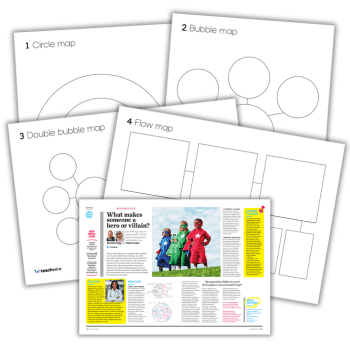Staff meeting – How to run meetings that matter

We’re all short on time, so being able to run well-structured, essential meetings is a key skill to develop…

- by Matthew Lane
- Religious education lead, author and editor for the Reforming RE project Visit website

How often have you left a staff meeting mildly (or very) disgruntled, muttering, “Well that could have just been an email”?
Time is a precious resource in schools. We always have more to do than we have time for, and having that essential resource wasted saps morale and goodwill.
Meetings should be a gathering of minds where all are heard and actively listened to. Supporting colleagues with purposeful staff meetings where they have their voices heard builds morale and permits teachers to do what we came into the profession to do: make a contribution.
So, how do we produce a meeting structure that actually makes an impact?
Is your staff meeting necessary?
While our rationale for meeting might be important to us, even providing us with a sense of importance or worth, it just might not be necessary.
The average person calmly speaks at 130 words per minute. If your item is a one-way broadcast of information and needs fewer than 500 words (which is how many fit on an A4 sheet in a size 12 font) then you don’t need a staff meeting. You need an email.
Your ‘meeting’ was really a five-minute transmission from you to staff.
Staff meeting preparation
Prepare a document in advance
Having assessed that you do really need a meeting, then, how do you get ready? Ironically, with an email.
Major companies such as Amazon, which brought the idea to global attention, prepare staff for a meeting with a memo. This document is the basis for the meeting structure; curating and fencing in what will be discussed during the time together.
Staff will then arrive with a grounding in the content you wish to discuss, and ready to share ideas; which is what a meeting structure should consist of: a meeting of minds, not the downloading of information.
Preparing a document in advance also means that you don’t spend time (and therefore energy and attention span) on giving staff knowledge of the subject matter, because they arrive prepared.
There are many ways to structure your memo and the details will alter a little depending on need.
Meeting document example structure
- Introduction: this provides a brief overview of the topic of the meeting, including the purpose, the goals that are being set, and the audience for the memo.
- Problem: identify the problem that the meeting is addressing. This could be a challenge that the school is facing, an opportunity that the school wants to capitalise on, or a new initiative that the school is considering.
- Background: context for the problem. This could include information about the history of the problem, the factors that are contributing to the problem, and the impact that the problem is having on the school.
- Solutions: an outline of the possible solutions to the problem. This could include a variety of options, such as new policies, tools, or initiatives. Provide no more than three possible options.
- Recommendation: this section should make a recommendation for the best solution to the problem. You should base this choice on the information that the memo presents, as well as the author’s judgment and experience.
- Appendix (optional): you can use this section to provide additional information that is not essential to the main body of the memo. This could include data, research, or other supporting materials.
The end product is not really the important part; it is the process of writing that matters. By putting your ideas down on paper, you are rehearsing and coalescing the content. You will find those blind spots or logistical snags that were not initially or superficially apparent.
Ban PowerPoints
It was for this reason that Amazon took the move back in 2004 to ban PowerPoints at meetings and move over to its six-page memo structure. Executives could no longer offload their presentation prep to juniors and wing the delivery.
These very busy and highly paid people were made to sit, think, write and craft their ideas; ideas that would then be challenged and discussed at the meeting. This approach does fundamentally shift how we deliver meetings.
Instead of distilling our points into a string of slides using pictures, keywords or three short bullet points for speed and brevity, we are now crafting a story; guiding our attendees through our thought process and asking for their feedback.
Think about attendees
Do you need all teachers? Do you need TAs or support staff? We do not need spectators at meetings; everyone needs to bring a contribution.
If you do not need every teacher at the meeting, ask SLT to provide tasks for non-attendees so you don’t upset the directed time calculations.
Just remember to put all teachers on the post-meeting email, to avoid those not invited feeling undervalued.
How to run a staff meeting
Start on time
If most attendees have arrived, begin rather than sap goodwill by awaiting stragglers. This also deflates someone who has decided to arrive late as a power play.
You cannot deploy the ‘thank you for waiting for me’ line if you’re sneaking in the back.
No distractions
Ensure everyone has a paper copy of the briefing memo. If people have brought computers with them, ask them to put these away. Devices bring distractions.
Allow time for staff to re-read the memo and then begin the discussions.
Use your document
Using the structure of your memo as an agenda, discuss each part in turn. Take staff views on the problem you are highlighting. Did staff agree with your background assessment? Did you miss something?
Talk through the possible solutions, fostering debate. If staff offer new ideas, note these but then come back to your points.
This part of the meeting can get tied up in knots of tangents if not led with purpose. Try to keep everyone in the same discussion, and if the group breaks into hustles of chatter, bring everyone back together again.
Summing up and actioning tasks
Afterwards (the next day is best), send everyone an email thanking them for their time and codifying the decisions made and the actions to follow.
Matthew Lane is a teacher from Norfolk. His new book Wayfinder: leading curriculum vision into reality (£16, John Catt), is out now. Follow Matthew on Twitter @MrMJLane and see more of his work at theteachinglane.co.uk










